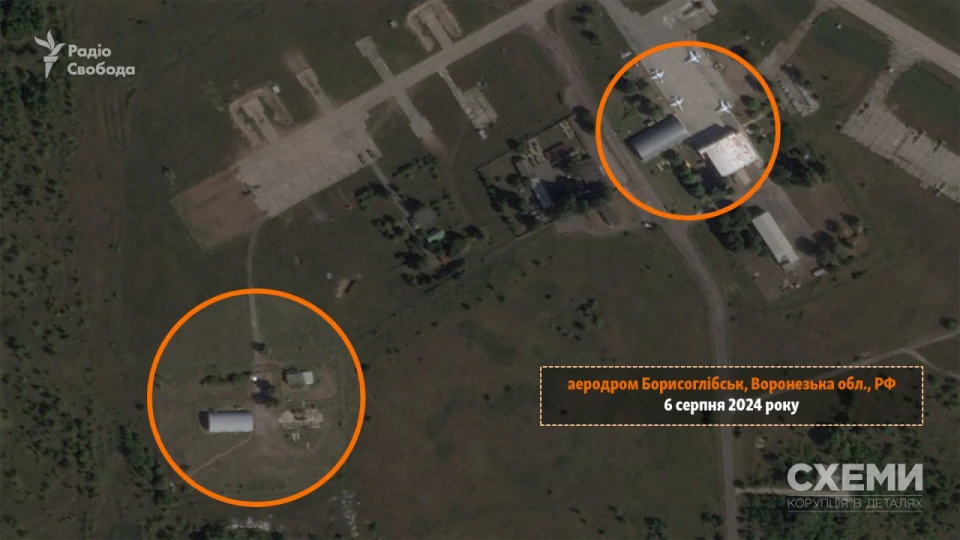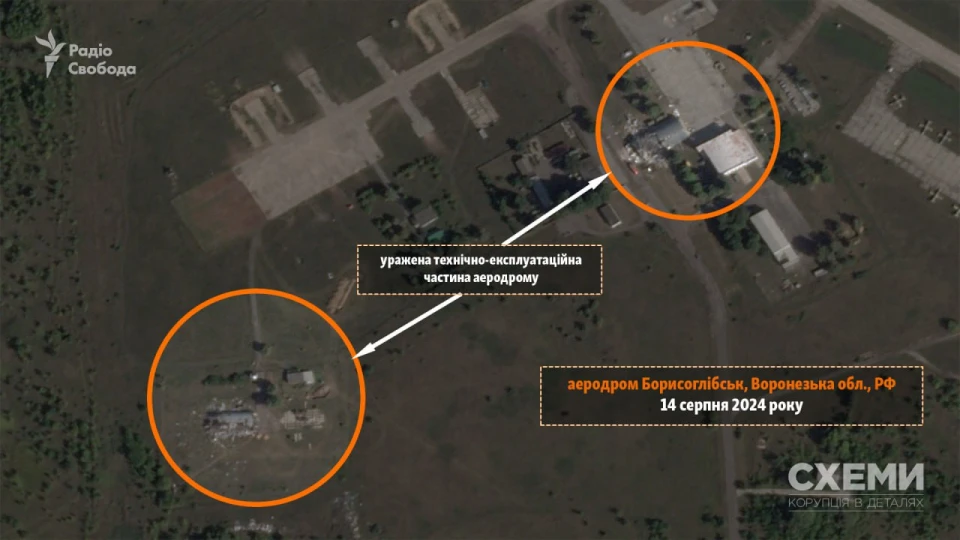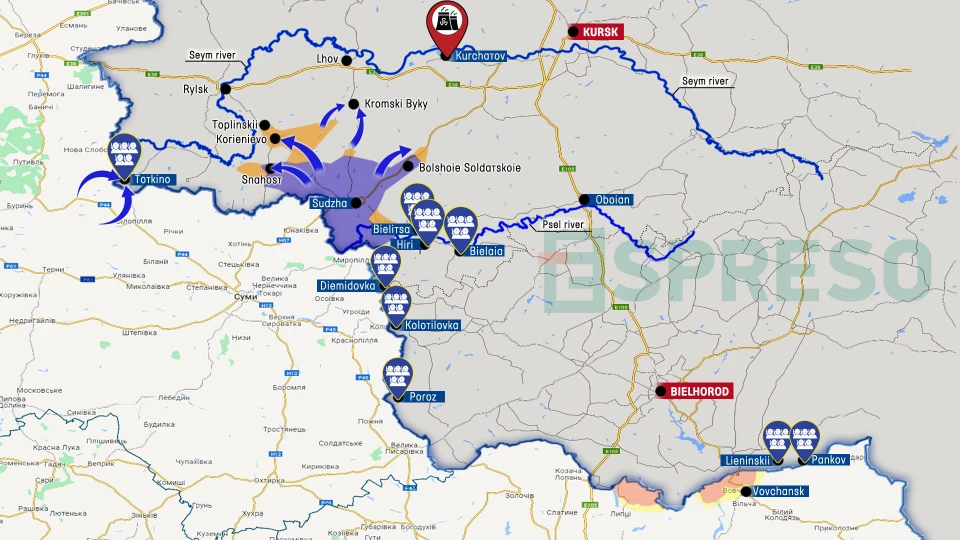
Ukraine's strike campaign against Russian airfields, combat operations in Kursk region. Serhiy Zgurets' column
On the night of August 14, Ukrainian drones hit Russian airfields. The Kursk operation continues: what has been achieved and what risks remain
Attack on Russian military airfields
In their bases, and on the night of August 14, in my view, a significant and powerful stage of Ukraine's air strike campaign took place, aimed at destroying Russian military aircraft, their stockpiles of munitions, and airfield infrastructure. Long-range drones from the Security Service of Ukraine (SBU), Defense Forces, Air Force, Special Operations Forces, and the Unmanned Systems Center carried out the largest attack to date on Russian military airfields.
Some are concluding that this was the largest attack of the entire war. I hope the largest is still to come, but in any case, yesterday's targets included several airfields. Of course, I started with Savasleyka for a reason, as one of the airfields attacked by drones was indeed Savasleyka. It is a base for MiG-31 aircraft and is located 650 km from the front line in the Nizhny Novgorod region.
What we know so far: NASA's satellite fire detection system has recorded fire outbreaks. These could either be arsenals with Kinzhal missiles or fuel storage for MiG-31 aircraft. There are also expectations that an Il-76 aircraft and possibly at least one MiG-31 might have been hit. This conclusion is supported by videos shared by the Russian military themselves, who attempted to repel the Ukrainian drone attack.
Additionally, the Savasleyka airbase has three open areas for aircraft, all of which are exposed. In any case, I hope the drone strikes were effective, but we'll wait for satellite images to confirm. Besides Savasleyka, there were also strikes on airfields in the Voronezh region - specifically, two airfields: Baltimor and Borisoglebsk, located 180 km and 340 km from the front line, respectively.
There are already satellite images of at least one airfield, Borisoglebsk, where Su-25, Su-30, Su-34, and Su-35 aircraft are based. In the western part of the airfield, there are strikes on hangars. Whether these hangars contain aircraft repair equipment or munitions will likely become clear a bit later.

Photo: t.me/cxemu

Photo: t.me/cxemu
The fourth airfield is Khailino, located 7 km from Kursk. There is the least information about this one, but I do not rule out that the Su-34 reported shot down yesterday by the General Staff might have been launched from Khailino. Overall, this suggests a systematic approach - a massive drone strike by Ukraine on a series of Russian airfields.
I would also mention the strikes on the Russian strategic base Olenya, which is 1,800 km from the Ukrainian border, as well as the strikes on Morozovsk, where significant stockpiles of Russian guided bombs were destroyed. Additionally, there were strikes on the Lipetsk-2 airfield. Overall, this points to a systematic approach.
Previously, Ukraine carried out strikes on Russian airfields, but what's changed now is that the strikes have become more extensive. The distances have increased, the number of drones used has significantly grown, and their capabilities have improved.
Kursk operation
Regarding the element of surprise - it's known to significantly impact the front line, as demonstrated by the operation in the Kursk region, where Ukrainian Defense Forces are advancing deeper into Russian territory. Overall, it can be estimated that the penetration is around 60 km, with depths of 10 to 30 km in certain areas. Yesterday, General Syrskyi reported to the Supreme Commander about further advances and an increased number of prisoners. The number of Russian prisoners over the week of combat ranges in the hundreds, and I believe the figures are approaching a thousand, including conscripts, FSB personnel, and members of Chechen units. This has significantly increased the Ukrainian pool for prisoner exchanges, which is one of the outcomes of this operation.

Photo: Espreso Map of hostilities for August 7-14
What has the Ukrainian military already achieved in the Kursk region and what are the risks
Valentyn Badrak, Director of the Center for Army, Conversion, and Disarmament Studies, military analyst, and writer, believes that the operation in the Kursk region has already affected the world's attitude towards the war in Ukraine.
"The whole world has been focused on the Ukrainian offensive in the Kursk region for a week now, and this is a significant achievement because the sudden offensive has influenced Russian society and Western society, including the political establishment, which has rapidly begun to change its view on how and to what extent assistance should be provided to Ukraine.
There has also been a significant increase in the prisoner exchange pool, which is very important. Most importantly, what has already been achieved is the demonstration of the weakness of the Russian military machine and Putin's regime, highlighting the fragility of the Kremlin's criminal regime as a whole. This is a major accomplishment. Some media have reported that the so-called "red lines" regarding pressure on Putin are beginning to fade in the minds or consciousness of Western politicians.
It is undoubtedly important that Russian forces have started to withdraw their units from the front line, including from the Kharkiv area and even from the Pokrovsk direction, which some military experts had described as critical. This is clearly a significant achievement and a strategic shift, marking a crucial moment of initiative. The fact that the operation is being described as brilliant is also very important.
I will briefly go through the countries that could change their attitude and have a serious impact on the further advancement of Ukrainian troops. These are the United States, which still maintains a ban on the use of missiles, Germany, on the contrary, is ready to allow it, but it did not provide us with cruise missiles, France is silent about cruise missiles, and Britain has spoken out against the use of cruise missiles.
That is, it turns out that for some time to come, Ukraine will again have to prove that conventional weapons can change the course of the entire war and actually nullify the ideology of nuclear confrontation, which could have happened at the end of 2022, then in mid-2023. And again, due to the slowdown in the West, this did not happen,” Valentyn Badrak believes.
Kursk operation risks
"Risks are certainly very serious, and in my view, this offensive emerged from desperation due to constant pressure from Russian forces and a lack of options. The problem was the shortage of reserves, key weapons, and ammunition. Now, by stretching the front line - which also increases risks - Ukrainian defense forces have managed to change the situation.
Military experts have now spoken out about the biggest risks. They are, first, the great depth of the advance. If Ukrainian troops advance more than 60 kilometers, it will be very difficult to maintain logistics, and if they advance even further, it will depend on the readiness of Ukrainian reserves. The same can be said about the flanks, closing the flanks is considered by military experts to be a very big risk and a big potential problem.
However, we do not have precise information about the reserves currently available to Commander-in-Chief Syrskyi. If we assume that at least some of the 14 brigades mentioned by Supreme Commander Zelenskyy (who lamented the lack of equipment for them) are operational - let’s say 4-5 brigades - then it is quite possible to further develop the success of this offensive and even achieve substantial consolidation.
By the way, it would be a very important element to consolidate and build a powerful echelon defense in the Kursk region. Here I cannot help but say that, in addition to engineering units, it would be very logical to enshrine private military campaigns in this form, but we have been talking about this for five years now and have three bills that experts call rather empty and far from how private military campaigns should be built. And this is a possibility of asymmetric actions, including powerful engineering works on the already captured territory,” the military expert noted.
Presidential elections in the United States
"Another very important aspect related to this offensive is the upcoming U.S. presidential elections. Kyiv was visited by two senators, a Republican and a Democrat - Lindsey Graham and Richard Blumenthal. These senators aim to propose a bill to secure assistance for Ukraine through 2025. This is a crucial measure to hedge against the potential return of Trump, so to speak.
Experts have analyzed the prospects for advancing such a bill and suggest that it would be very important if Kamala Harris, even if she did not win, at least competed on an equal footing with Trump, or ideally, if she won. This would serve as a marker for Speaker Johnson to consider the bill to enhance his own political position. Currently, Johnson is quite dependent on Trump, and if Trump were to win and advise against the bill, Johnson might not bring it forward. However, if Kamala Harris were to win, Johnson would need to introduce the bill by November 5 and ensure it is considered by the end of December.
Thus, Ukraine's future is once again partly dependent on American politics and the outcome of the U.S. presidential campaign. We hope that Kamala Harris will gain momentum," noted Valentyn Badrak.
How Putin clan will respond to Ukrainian offensive
"There is indeed a significant danger and risk associated with the simplified approach to defense and the seemingly easier advancement of Ukrainian troops. The Kremlin might create a trap and lure the Defense Forces more than, for example, 80 km deep. If this happens, success will depend on the availability of well-prepared and strong reserves (if they exist). If there are sufficient reserves, Ukraine can develop the success and, if necessary, shift to defense. However, if reserves are lacking - evidenced by the fact that wounded Ukrainian soldiers were redeployed from other fronts just a day before the offensive - such a trap could be very dangerous.
Therefore, Russia's actions - while it seems they are just recovering from the surprise and starting to implement responses - might artificially slow down their preparations. They could deliberately delay the setup for counterattacks and position reserves further from the front line, say 20 to 30 km back. Much will depend on reconnaissance and targeting capabilities, where Ukraine has already demonstrated significant power. This is evident both in the damage to airfields and in the effective use of sniper artillery against reinforcing units. Ukrainian Defense Forces currently have a substantial advantage, and indeed, we see that the initiative is in their hands. This has led to an uplift in morale and combat spirit, which is a crucial aspect of this war. The offensive has already achieved its role, regardless of the outcomes of future negotiations," added the military expert.
- News












































